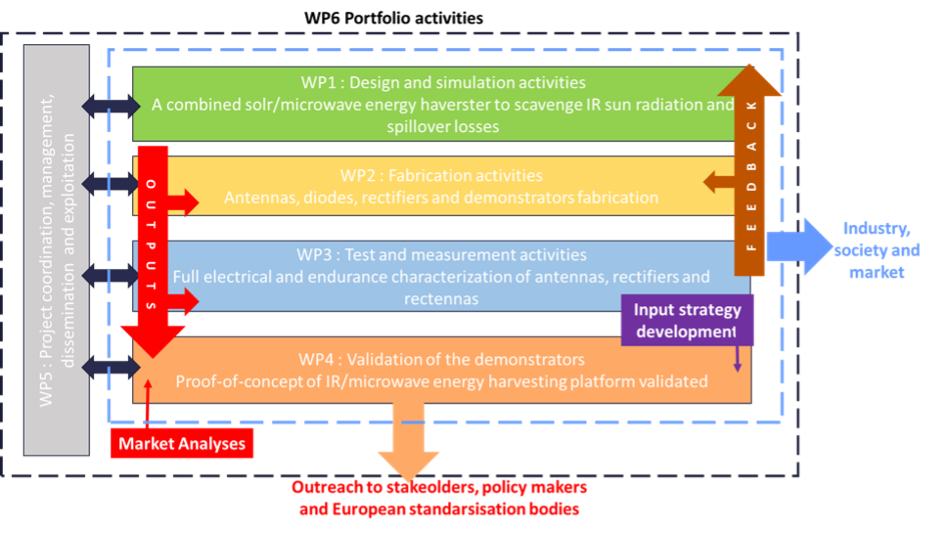Description of Work Packages
The achievement of the proposed objectives can only be fulfilled through a well-coordinated effort. This undertaking involves tasks including system architecture, design and simulation of devices, material growth and characterization and fabrication of devices, test activities, system integration and, ultimately, technology transfer of the results achieved.
The POWERSAT consortium consists of three universities (UCC, UU, and UNIVPM), two research institutes (IMT and FORTH), one SME (FADO), and a major company with expertise in satellites and space applications (THALES), representing six European countries. The eight partners form a highly interdisciplinary team with R&D expertise and skills in semiconductor materials and nanoelectronics, materials science, EM/multiphysics design and modeling, micro- and nanofabrication, as well as 2D materials deposition and characterisation, device/component testing, and validation. This highly complementary set of competences is needed to meet the ambitious project’s objectives and each partner plays a unique, non-redundant role in the work plan, providing expertise and critical infrastructure in the fields of semiconductor and 2D materials, TCAD simulation, electronics, EM/multiphysics design, rectenna fabrication, system integration, electronic test expertise, and manufacturing. The integration of social sciences and humanities is not required to deliver the project’s short term and long-term impacts because the work is mostly technical in nature.

The POWERSAT project consists of six work packages. The coordination, management, dissemination, and exploitation correspond to WP5. WP1 deals with design and simulations of the rectennas at high frequencies, while it also lays down the specifications and end user’s requirements. WP2 is responsible for the fabrication of all antennas, diodes, rectifiers, their integration technology, and finally the realization of the demonstrators. WP3 deals with the tests and measurements of antennas, rectifiers, rectennas, and reflect arrays for ISL communications, together with endurance assessment for the rectifiers in terms of temperature/incoming power/radiation exposure. The outputs of WPs1-2-3 will be combined in WP4, which is devoted to the characterization and validation of all demonstrators and
to the LCA & LCC assessment. Portfolio activities: WP6 is the “Portfolio activities”
WP1 (Design and simulation activities)
- Establish end-user requirements and specifications for in-orbit energy harvesting.
- Design and simulate all the antennas/antenna arrays envisaged in the project.
- Design, model, and simulate all the diodes and rectifiers, i.e., including input matching networks and DC circuitries in output from the diodes to use the harvested DC voltage.
- Design and simulate all the five demonstrators of the project and the reflect arrays for ISLs.
WP2 (Fabrication activities)
- Fabricate all the antennas/antenna arrays envisaged in the project.
- Fabricate and characterize the oxide materials for the MIM diodes.
- Fabricate and characterize the 2D materials for the SSDs.
- Grow and characterize epitaxial materials and fabricate all the Schottky diodes and rectifiers.
- Fabricate all the five demonstrators of the project.
- Fabricate the reflect arrays for ISL communications. At least two fabrication runs per demo are foreseen.
WP3 (Tests and measurements activities)
- Full THz/microwave characterization of antennas and antenna arrays.
- Full DC and THz/microwave characterization of diodes and rectifiers.
- Endurance test of rectifiers under different temperature/input power/ions irradiation conditions.
- Full THz/microwave characterization of all rectennas in the bands of interest.
- Full microwave characterization of the reflect arrays and demonstration of the ISL communications.
WP4 (Validation of the demonstrators)
- Validation of demonstrators (TRL3) for solar IR spectrum and in C/X/Ku/K-bands.
- Development of required firmware for driving the arrays.
- Evaluation and verification of the demonstrators in test facilities (anechoic chamber, etc.).
- To determine the environmental (LCA) and cost (LCC) performance of the target demonstrators.
WP5 (Project coordination, management, dissemination, and exploitation)
- Project coordination and internal communication.
- Data management.
- Dissemination and training.
- Documentation of the demonstrators both for continued use and external
- Standardization and regulation.
- Initial exploration of market traction of the innovation.
- Industrial exploitation roadmap including the establishment of the IAB

The Powersat project is funded by HORIZON-EIC-2023-PATHFINDER CHALLENGES-01 under the grant agreement 101162320
About Powersat
POWERSAT is developing a new energy harvesting platform that captures unused solar infrared (IR) energy and microwave spillover from satellite antennas. It uses rectennas to gather energy from various microwave bands to power low-energy satellite electronics. The project includes five demonstrators and aims to connect satellites through low-power inter-satellite links while reducing overall satellite weight and launch costs.
